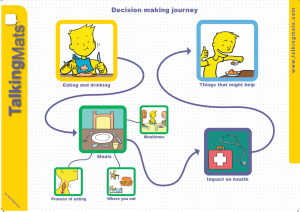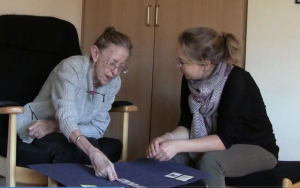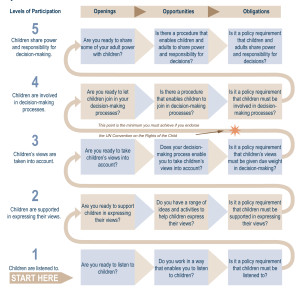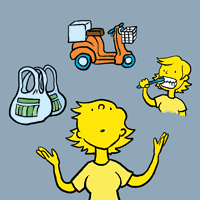The Talking Mats Eating and Drinking resource provides insight into what service users perceive their difficulties to be and can help raise issues that care providers are unaware of.
Gillian Callander, speech and language therapist wrote the following review.
I have used this Talking Mats resource with adults with learning disability and it has been a valuable tool in discussing issues that they have with their eating and drinking and in providing a focus for discussion. It helps understanding of what can be an abstract and complex subject and can aid the planning of next steps.
There are 3 symbol sets included with the resource
- Meals
- Health
- Things that might help
I have also used this resource with additional personalised symbols to discuss potential specific changes to eating and drinking and to gather information about how the service user would feel about this. There were blank symbols included with the resource which can be used for this purpose.
The symbols in this pack provide a range of subjects to be discussed and are clearly categorised. I have found that for the service users I work with that the “meals” set and “things that might help” have been the most relevant and easiest for discussion and the symbol sets provided ably support this. The “health” category is a little bit more abstract and is harder to discuss with this client group, particularly if this issue is one that may occur but currently is not causing any difficulties. However, it does provide a basis and support for this discussion and helps to tackle issues that are more complex and abstract.
I have found that using this Talking Mats resource has provided increased clarity during discussions with service users about eating and drinking and it provides service users with a more consistent method to express feelings about eating and drinking and the impact of any difficulties. It also supports me by giving a way to convey the information about concerns or potential changes to eating and drinking using the same method of communication as the service users, thus providing a method to enhance two way communication and facilitate discussions. It helps to ensure, that as far as possible, service users are able to input into the discussion about their eating and drinking and to make their opinions known. Using the Talking Mats has helped to provide evidence that service users do/do not understand the information being presented and can help decide outcome with regard to capacity for decision making.
Based on my experience of using this resource, I would recommend this as a valuable addition to your eating and drinking assessment tools.
Gillian Callander
This is the second of Kristine Pedersen’s projects using Talking Mats as a tool to support people with dementia.
Care workers at two residential care homes in Denmark were taught how to use the Talking Mats framework and how to incorporate the method into planning daily activities for people with dementia.
The care workers gave positive feedback in regard to using Talking Mats:
- Using the Talking Mat framework provides important knowledge about communicative difficulties of the person with dementia
- Talking Mats helps people to understand their options and thereby motivates to social activities, eating, physical exercise, etc.
- Talking Mats increases the possibility of active participation in caregiving plans
- Talking Mats enhances the joy of work, when I know how I can give the right care
- The Talking Mats conversations support a closer relation between elderly and care giver
This project and the one described in the previous blog, gave the opportunity to explore the Talking Mat framework in use and how the framework can support the communication of people with dementia. Very importantly, due to the adoption of Talking Mats and its extension in Denmark, the projects gave a lot of Danish examples. The projects also gave important information about how to implement the tool in care homes for people with dementia within a Danish setting.
‘We are very grateful to the Directors, Dr Joan Murphy and Lois Cameron and everyone on the team at the Talking Mats Centre who developed the framework and who continue to increase knowledge of Talking Mats through research and education. It is a very helpful tool for many people and supports and enables more people to have their views seen and heard’
And we are grateful to Kristine for sharing her projects with us.
Get your New Year’s resolution Talking Mat here!
Talking Mats is a social enterprise whose vision is to improve the lives of people with communication difficulties. 2015 has been another exciting year for us. We have had great opportunities to work with a fantastic range of people and hear great stories: from wee ones in nurseries using Talking Mats to encourage active participation and decision making, to older people and their families through our dementia family training project. It is our core belief that good communication is fundamental to a quality service. Making sure there is space for active listening to views and concerns particularly, if individuals have difficulties communicating is central to effective interactions and individualised, person centered care. We are really grateful to all the people who have supported the work of Talking Mats; people with communication support needs, staff who work with them and organisations that we are privileged to work with on a consultancy basis.
It will not surprise you to know that as an organisation we like to set goals and then go for them so as our thank you to you all for your continued support , we have created our very own New Year’s resolution Talking Mats;
• What are you definitely going to go for ?
• What is in the maybe pile – or that could be for those things you are already doing and will continue
• What is not a goal for you in 2016 .
• Don’t forget to use the blanks to personalize it further!
• Plus take a photo so you can reflect back on where 2016 takes you and whether you achieved your goals .
So open and download it , cut it up and we hope you enjoy using the resolution Talking Mat with friends and family ! resolution pics
We wish you all every health and happiness from all in the Talking Mats team
We are grateful to Emma Atkiss, one of our accredited trainers for this interesting report.
The purpose of The Voice of the Child pilot project carried out by the Wigan Pathfinder team was to obtain pupil views using a viable tool. The team selected Talking Mats as a framework to support pupils to express their views in decisions regarding their lives. They were working on the principle that engaging with the young person and his/her family would lead to better outcomes
The project team considered that Talking Mats met the 5 criteria of Shier’s model of participation (2001)
- Children are listened to.
- Children are supported in expressing their views.
- Children’s views are taken into account.
- Children are involved in the decision-making processes.
- Children share power and responsibility for decision-making.
Click on diagram to enlarge.
The pupils in the pilot ranged from 7 to 17 years with a range of disabilities. During the pupil interviews the team found that the Talking Mats Health and Well being resource provided a practical framework for decision making and target setting
Talking mats provided :
- An objective, neutral space – a thinking tool- ‘Children and young people are able to consider their priorities when setting targets’.
- Opportunities for change – ‘Children and young people are able to make changes to their initial thoughts and have time to decide and reconsider options’.
- A truly person centred approach
- It was fun!
For example : A seven year old child with Autistic Spectrum Disorder identified both her cognitive strengths and areas for development using the Learning and Thinking domain. She provided feedback regarding her difficulty in attending when faced with too much information or choice and also her strength in planning skills. Thinking skills targets and interventions can be developed using this information as a starting point.
Their report states that the information gained from Talking Mats can be used, as part of the Education Health and Care planning and review cycle, to inform both decision-making and goal setting for children and young people i.e. It identifies strengths; It identifies areas to develop; It identifies the child / young person’s response to a range of experiences; It informs day-to-day decision-making ; It informs both targets and interventions for Individual Education Plans and it supports transition planning.
Ref : Engaging the voice of the child / young person at an individual level – Emma Atkiss,Senior Educational Psychologist and Caroline Gomez, Educational Psychologist, Wigan council
Sophie Mitchell SLT describes how she supported her students to develop their EHC Plans with the Talking Mats app .
In September 2014 our team and I were asked to facilitate the production of Education and Health Care plans for the Year 14 students at the Secondary Special School (for adolescents with complex, profound and multiple learning difficulties) where we are based. As Speech and Language therapists we were asked to work with the students to gain their view on what they would like to be detailed in their plan and also what their aspirations were for their future. We wanted to ensure the production of these plans were as client centred as possible so therefore decided to use the Talking Mats App on the Ipad using the Health and Wellbeing resource. This resource proved invaluable when working with our students. Not only were our students highly motivated to participate in the sessions due to the Ipad being used, talking mats empowered them to make meaningful decisions about their future, communicate any areas where they would like further support and discuss likes and dislikes. The impact on our students became clear when working with one 19 year old student. Although he did not have any spontaneous expressive language and would only echo things said by others, during a Talking Mats sessions when talking about his likes and dislikes, he appeared to be placing most items under ‘dislike’. As the session went on the student started to appear agitated, then started pointing towards ‘like’ although no symbol was presented. Suddenly the student said ‘Garden’, still pointing towards the ‘like’. When presented with a gardening symbol he soon placed this under ‘like’. This information was then presented in his plan and his college were instructed to explore opportunities for this student to develop his gardening skills. For all students this information was then used to not only create their Education and Health Care plan but also expand and explore areas they were highly motivated by while still at School and also identify possible work placements for the future. Furthermore the School invested in Talking mats training to ensure this approach is used throughout each academic year and school staff are skilled to use Talking Mats as each student starts their assessment for their Education and Health Care plan.
We would like to thank Sophie who is from Sandwell and West Birmingham NHS trust for such a great example of how to use the app in EHC Planning . If you are interested in purchasing the digital Talking Mat then please phone the office 01786479511. We are just changing the purchasing model from subscription to one off sale so its temporarily removed from the web site.
We are very grateful to David Brennan, a Dementia Support Worker from Ayrshire for this powerful blog.
Over the years our service has supported many people with a diagnosis of Dementia, now and then we encounter individuals whose cognitive difficulties have greatly affected their ability to communicate. This can (in some cases) result in distress for the services user and their families, distress that could be reduced or even avoided if the individual had a way of being understood by those around them.
As a service we welcomed the opportunity to engage in the Talking Mats Training and as a Dementia Support Worker I was eager to have a tool that could help me overcome communication obstacles, having experienced situations where those I support become so frustrated because they desperately want to relay a piece of information, but simply cannot find the words to express themselves.
I saw talking Mats as a communication system for those who struggle with speech. However, after using the practice in a practical environment I realise that I have had underestimated its potential, for it has much wider applications in our role.
My first experience of using Talking Mats was when producing the video for the second training session. I enlisted the help of a gentleman from the neighbouring Day Care centre.
We had never met prior to the session. The Gentleman had no communication difficulties that I was aware of.
Using the Talking Mats acted as an instant ice breaker, giving two complete strangers a reason to sit down and interact together, quickly striking up a rapport. The Gentleman appeared at ease and was happy to talk in detail about the tiles for the chosen subject of ‘Leisure Activities’
The activity revealed more than expected though. Through the course of the conversation he voiced feelings on things he was perhaps not happy with. I discovered he was unhappy that he did not get out in the open air enough due to poor mobility and that he would have preferred to see musicians coming into his Day Care Centre. This was crucial feedback
It occurred that Talking Mats also had an effective use in the assessment and quality assurance process that exist within services, providing crucial feedback for continued person-centred planning.
Taking this on board I considered examples of service users within my current caseload where the activity could prove beneficial.
I have been working with one gentleman for many months. He could be described as a Man’s man, someone who often replies to attempts at conversation with short responses, even when speaking with his wife. He may struggle to remember the names of people and places but he typically has little other difficulty in communicating.
I attempted the same topic with this man. Much of the answers were as expected. He spoke about football and his favourite team, but the structure of the Talking Mats encouraged him to open up about some of the smaller details that until now he hadn’t felt the need to disclose.
In the most recent example I was asked to take part in a colleague’s Talking Mat video for her training. She is one of our newest members of staff and although we have already developed a good working relationship the activity allowed her more insight to the nature and history of her co-worker.
For my experience, as someone who can struggle with sensory stimulation, it allowed me to express some of my needs and obscure preferences (around the office and in general) in a safe environment where I felt able to communicate what would normally be very personal information. And to have someone listen and thoughtfully consider this was a rewarding experience too.
As a service, new to the Talking Mats system, we are just scratching the surface of how we can best implement this into our roles, but the possibilities are already multiplying at a rapid pace, almost as much as the benefits we are seeing.
David Brennan
Dementia Support Worker
What are social care outcomes and how do we measure them? The Adult Social Care Outcomes Toolkit (ASCOT) was developed over a number of years as a way of measuring user views on their social care. The ASCOT has been developed by researchers at PSSRU, University of Kent http://www.pssru.ac.uk/ascot/index.php
There are eight domains of ‘social care-related quality of life’ included in the ASCOT. These include:
- Control over daily life
- Personal cleanliness and comfort
- Food and drink
- Personal safety
- Social participation and involvement
- Occupation
- Accommodation cleanliness and comfort
- Dignity
The measure has been tested with service users from different user groups and there are a number of different versions available, including an easy-read version.
Many people with who have communication difficulties are not able to provide views via interview alone. Talking Mats is a communication tool that can be used with people who have communication difficulties. The mat consists of a set of symbols or pictures that are tailored to the subject you want to talk about.
The ASCOT Talking Mat: Tizard Centre’s Jill Bradshaw with Ann-Marie Towers and Nick Smith (both from PSSRU) have worked with the Talking Mats team at Stirling to develop three ASCOT Talking Mats. These will enable people to give their views on:
- Where I Live. This is a starter mat, designed to introduce people to the approach and for those people who might find more abstract concepts more challenging;
- My Care. People will be supported to give their views about whether aspects of their care are going well or not going well.
- Control over my Care. People will be given tools to think about how much choice they have over different aspects of their care. The second and third mats have options for both basic and more abstract concepts.
The TM version of the ASCOT will enable researchers to investigate user views regarding social care outcomes. By using this more inclusive methodology we will be able to engage with these seldom heard groups. The use of symbols in combination with a structured approach will enable us to represent these participants’ own feelings/perspectives in the research, rather than us having to rely on the views of proxies.
Researchers at the University of Kent will be piloting the ASCOT Talking Mats with people with dementia and people with intellectual and developmental disabilities (learning disabilities).
Jill Bradshaw (Accredited trainer) Lecturer in Learning Disabilities, Tizard Centre, University of Kent
Ann-Marie Towers (Research Fellow) and Nick Smith (Research Officer). PSSRU, University of Kent
Background
Social workers are required to complete a detailed assessment of their client’s needs. It is recognised that it can be a challenge to ensure clients fully participate in the process if they have cognitive or communication difficulties. The City of Edinburgh Council were keen to explore if we could adapt their standardized assessment tool and make it into a Talking Mat framework. Several staff in the council are already skilled practitioners in Talking Mats so are familiar with the framework and use Talking Mats in their practice. They are enthusiastic about the benefits of using Talking Mats both in terms of how it increases participation of service users but also because in their view it makes interviews easier for staff to undertake.
Structuring Talking Mats assessment framework
In order to develop the bespoke Talking Mat we held a seminar to discuss the social work assessment tool and approach used. Six key staff attended the seminar, facilitated by two Talking Mats associates. The discussion at the seminar identified a structure that would enable us to construct a coherent visual conversation that would cover the issues required to complete the assessment, using mind mapping to support this process. It is also important to identify a top scale that matches the question you are asking and make sure the options you are including are neutral and not leading.
The structure that emerged from this discussion is a Talking Mat that enables people to explore their views on 3 topics
- their home
- their health and well being
- their community involvement
Trialling the Talking Mats framework
Talking Mats then took the mind maps and developed these into symbol sets that were piloted by social work staff. At the end of the pilot a review was held and changes made which included alterations to
- the language used
- the symbols used
- the topic an option was included under
- making it clearer to staff when options were more abstract and required further explanation and or personalisation
Nicki Ewing from Edinburgh City Council who leads on the project says ‘ I am very excited that staff have a tool that can make assessment more meaningful for service users to participate in and makes it easier for staff to get good quality information’.
Next steps
We are thinking of holding a focus group for others that might be interested in using the framework for their practice if, you are interested please contact Lois via the info@talkingmats.com email – call your email ‘social work focus group’.
Many of you have requested the ability to add your own photos into the digital Talking Mat.The new version of the app allows you to do just that.
It is a great feature particularly, if you want to reflect on a particular activity like a day out or a holiday. I thought I would try it when I returned from my recent holiday in Spain . You can see I had a great time the only one downside was the flight (as for some strange reason my husband, Jon and I were not placed in adjacent seats) . I placed shopping in the middle (I might have done a little bit more but I know it’s not really Jon’s cup of tea so I restrained myself!). However there were lots of things I loved, seeing my son in his new apartment in Madrid was great, the walking in the Sierra Nevada stunning, though did involve a lot of up and down ! and Grenada, well, the Alhambra has always been somewhere I wanted to visit and it did not disappoint.
I know that in Talking Mats we have always been slightly cautious about the use of photos but I think where places are concerned and where the photos relate to the immediate experience of the person then they can be really helpful. However, I also think the difference in the image ‘going out for a drink’ and ‘meals out’ demonstrates clearly the pitfall of photos. In the ‘meals out’ photo that I took there is too much visual information and without the written caption you probably would struggle to guess what that photo means. The symbol of ‘going for a drink’ is much clearer and will work for lots of ‘going out for a drink’ situations.There is an additional risk that that the photo of my ‘meals out’ that I took becomes too specific to that particular meal rather than mean ‘meals out’ throughout the holiday if I had taken a photo of a more generic plate of food that might lessen that risk.
Maybe I should have used this photo!
Adding images from your camera roll is an easy feature to use. After you have selected your thinker and added a new session you get to the ‘session set up’ page. There is a button on the top left hand page that says ‘Add local image file’ click this and go to your camera roll. Select the image and type the caption. you can select as many images as you need. The images will then appear after the blanks when you carry out the Talking Mats session with your thinker.
I think this new feature of being able to add your own images means that you could use the Talking Mats in really creative ways. It would be a great way to reflect on a trip e.g. schools could use the photos to talk to the children about their experience of a particularly outing. This could be the basis of a great group discussion projected onto a white board. It could enable people to reflect and express their views on all type of experiences e.g. transitions, work experience, going to college, where to live, visiting their health centre etc.
If you already have the digital pro you will get a free upgrade to include this feature. If you don’t have the digital pro version and want it click here to buy
We are delighted to announce the release of Version 2 of the Talking Mats App
This app has a number of great new features which many of you have been asking for.
There are two new resources – Eating and Drinking – which has 3 main topic sets – Meals, Impact on Health and Things that might help.

There is an amazing new feature which many people have been asking for. Version 2 allows you to add your own images from your camera roll. This means that you can add you own personalised pictures to any of the topics.
Watch out for next week’s blog when Lois will tell you about her holiday using this new feature!
You can now also reset your password, use the Back button to navigate through the app, delete individual sessions and use the updated report page.
If you have already purchased the gold version of the Talking Mats app you will get all these new features for free.
If you wish to purchase the app please click here or for further information call our office 01786 479511
 Online training login
Online training login 







